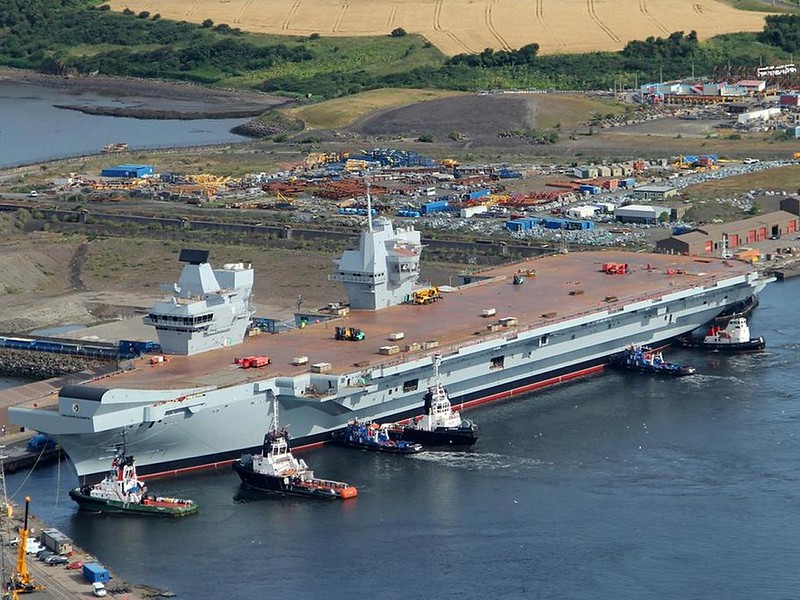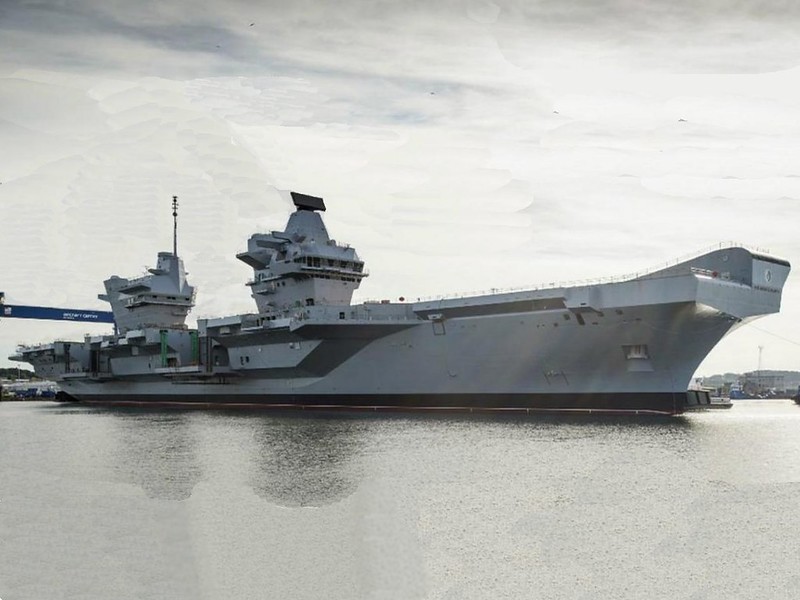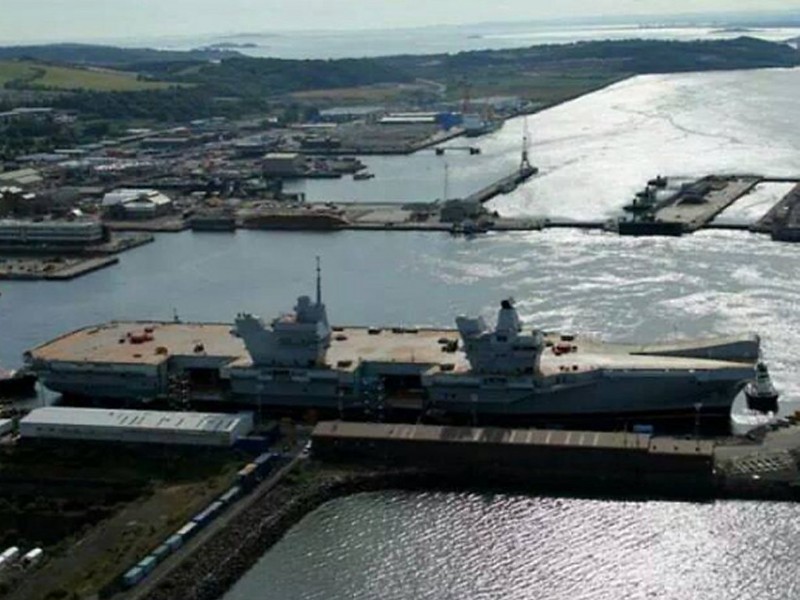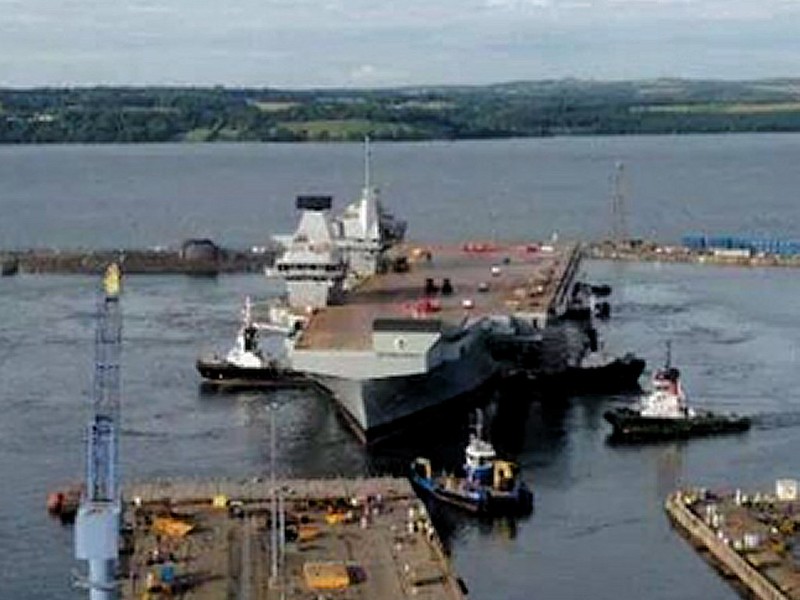Here are some of my pics there:





Posted on 07/19/2014 3:28:37 PM PDT by Smartisan
Britain’s biggest ever warship HMS Queen Elizabeth took to the water for the first time today as she was moved out of dry dock.
Rosyth, UK – With just two metres to spare at either side of the 65,000-tonne aircraft carrier, a flotilla of tugs inched the ship from the dock where she was constructed at Rosyth, near Edinburgh, to a neighbouring jetty where she’ll be completed over the next two years.
After a two-day operation to flood the cavernous dry dock, tugs began the delicate task of moving the leviathan in her entirety for the first time at dawn today.
It took just three hours to complete the ‘float out’ – an operation which took place 13 days after Her Majesty the Queen officially named the vessel in a spectacular ceremony.
(Excerpt) Read more at globalaviationreport.com ...
tons?
> Pounds?
I think that’s Sterling. Don’t know how many shillings that would be or it is before or after decimalization. ;-)
LOL, ‘you’ really couldn’t make him sound convincing as a character in a thriller novel.
I don’t believe it is ignorance, he does it too often and too well, it is an infantile attempt at being clever.
As long as we all know he’s a prat, we can all laugh at him together. :)
needs a ramp to launch aircraft, and it won’t be operational with aircraft until.......2020
I’m not so impressed.
but then, it’s not so clear that the UK has any use for aircraft carriers anymore
Why 2 islands? It seems a bit strange.
very nice pics
Two reasons.
1) separate operations. Manuevering forward, air ops aft.
2) Redundancy. They are both wired to handle both operations. If a SSM takes out one, they can operate with the other.
Expensive...but worthwhile if you can afford it, both financially and in terms of deck space. The Royal Navy decided it could.
3) For survivabilty the gas turbine plant is separated, two islands allow shortest in hull ducting for the exhaust.
interesting
I served on a USN carrier on the flight deck (catapults).
I really don’t understand why the Brits went with two islands on the starboard side.
I guess its some kind of system redundancy. But IMO its sure is fugly.
Britain needs a full-spectrum capability blue water navy because it is an island nation that depends on the security of the seas for its survival and livelihood, that is why we need carriers. Given that oil production in the Falklands is scheduled to begin in earnest once these carriers are ready duty, they are needed to help deter Argie aggression for a start.
Admittedly, it would have been better if they had cats and traps, but they are designed to be able to be converted into that configuration in the future if the future demands it.
I do wonder however, if carriers won’t be made redundant against all but the most pisspot of coastal nations though now that the Chinese have invented the ‘carrier killer’ DF-21D ballistic missile. Given that Chinese and Argies have been forming military links lately, it is probably only a matter of time before the PRC sells them these killer missiles and would make it virtually impossible for even a Ford Class carrier group to retake the islands.
Yup,
I was making the points in what I think are similarities in design.
The ski jump allows the aircraft to get airborne with a greater take off weight, than a STOVL jet would do from a flat deck.
It’s vastly more capable compared to something like the USS America.
Substance over style, every time.
Yes...the phantom DF-21D.
It is a dangerous proposition...but to date it has been a system principally on paper, and with some videos of launchers being towed around and put into place as if though deployed.
We cannot take anything for granted, but I do know this. They have never done a full-up, live fire test of the DF-21D system against a manuevering target at sea. They have shown us some photos of holes in the desert against static targets outlined to look like a carrier deck.
Big woop.
Such an actual, operating weapon system would be a very many many live tests.
Hitting a US carrier 1,000 miles and more at sea is not an easy proposition in the least. Extremely complicated.
1st, they must acquire the location, speed and heading of the carrier. In peace time this is hard enough on the open sea...in war time, when they are operating in a non-emitting or limited emitting manner, it will be extremely difficult. Their surveillance, satellite, and sub-surface assets have to be looking in the right places and the US Navy will make that very difficult.
Then they have to communicate this info to the targeting and firing system for the missiles. Again, a very complicated and involved system, particularly in a war time environment.
Then they fire the missile and we will be looking for and in all probablity see the plume of that launch.
It then takes (depending on distance) another 10-20 minutes to arrive where the carrier hadd been observed. In that time the US carrier (if they located it properly to begin with) will have moved anywhere from 10-17 miles...in any direction. So the warhead has to re-acquire the carrier once it re-enters the atmosphere.
It will have to do this in a very high EW environment, where the US will have all sorts of passive ghosts and shadows out to keep it from acquiring the carrier, and all sorts of active measures aimed at scrambling is electronic brains.
If it has overshot the carrier (IOW, if the carrier has sailed toward the missile firing location), the missile will have a very, very difficult time manuevering back on its own track at ballistic speeds to hit the carrier.
Finally, if they accomplish ALL of that...then they are charging into the teeth of the most sophisticated, most capable anti-missile system on earth. Where the AEGIS system aboard cruisers and destroyers will be protecting thecarrier, including against ballistic missiles.
And we have conducted many, many live fire tests against all of those types of targets...and done so successfully.
If the warhead survived that gauntlet, then it has to get past the carrier’s own defense zone of ESSM missiles, RAM missiles, and Phalanx CIWS...and which with the Ford carriers will soon include laser and/or Rail Gun defenses.
Now, when you consider the monumental tasks involved in ALL of that, and then add to that that they have never tested those missiles, much less the entire system with all of its C4ISR components against a manuevering target at sea...
I vry confidantly call the DF-21D a Sun Tsu deception program that is meant to get the US Navy to avoid using its most capable strength against the Chiense.
Sadly, with the likes of some of the planners and admirals that people like the Obama Administration have puit in place...it is working.
I was wondering how it might cope in the hands of the argues deployed against a Royal Navy task force. From what I understand, as an individual AA destroyer, the Daring class is better than an Aegis, but does not benefit from the same level of integration with other ships, and due to the inferior range of the F35B, will have to come within about 600 miles of anything it wants to strike, rather than 1000+ miles. Obviously, as a non nuke carrier, the HMS Queen Elizabeth won’t be able to manoeuvre as quickly either. Would it even have enough juice to generate enough power for directed energy weapons? From what I can see, the new British carrier might be useful for taking on some tin little third world power where the height of military tech is a machine gun bolted to a truck, but what against a power that has reasonably advanced tech?
It doesn’t make sense not to put ski jumps on the America class, other than they want to deliberately degrade their capability so that congress cuts funding for super carriers and uses the amphibious assault ships with Harriers/F35Bs instead.
Argues=argies
Disclaimer: Opinions posted on Free Republic are those of the individual posters and do not necessarily represent the opinion of Free Republic or its management. All materials posted herein are protected by copyright law and the exemption for fair use of copyrighted works.